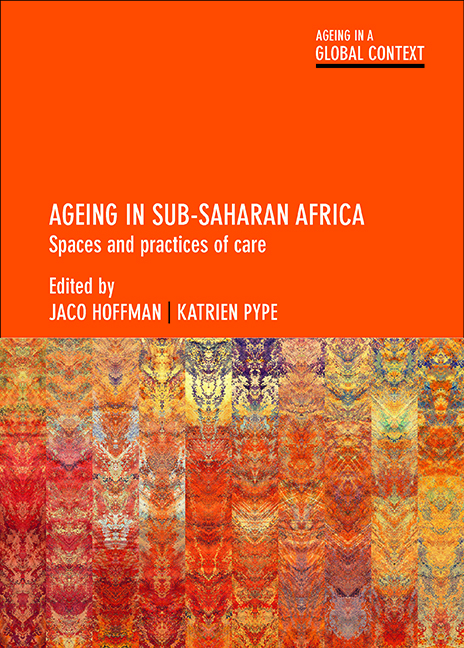Book contents
- Frontmatter
- Dedication
- Contents
- Lists of photos, figures and tables
- Notes on contributors
- Series preface
- Acknowledgements
- Introduction: Spaces and practices of care for older people in Sub-Saharan Africa
- one Will families in Ghana continue to care for older people? Logic and contradiction in policy
- two Caring for people ‘without’ value: movement, reciprocity and respect in Kinshasa’s retirement homes
- three Older people providing care for older people in Tanzania: against conventions – but accepted
- four Place matters: the home as a key site of old-age care in coastal Tanzania
- five Care and identity in rural Malawi
- six Making sense of neglect in northwest Tanzania
- seven Negotiating care for older people in South Africa: between the ideal and the pragmatics
- Afterword: Discourses of care for older people in Sub-Saharan Africa: towards conceptual development
- Index
two - Caring for people ‘without’ value: movement, reciprocity and respect in Kinshasa’s retirement homes
Published online by Cambridge University Press: 05 April 2022
- Frontmatter
- Dedication
- Contents
- Lists of photos, figures and tables
- Notes on contributors
- Series preface
- Acknowledgements
- Introduction: Spaces and practices of care for older people in Sub-Saharan Africa
- one Will families in Ghana continue to care for older people? Logic and contradiction in policy
- two Caring for people ‘without’ value: movement, reciprocity and respect in Kinshasa’s retirement homes
- three Older people providing care for older people in Tanzania: against conventions – but accepted
- four Place matters: the home as a key site of old-age care in coastal Tanzania
- five Care and identity in rural Malawi
- six Making sense of neglect in northwest Tanzania
- seven Negotiating care for older people in South Africa: between the ideal and the pragmatics
- Afterword: Discourses of care for older people in Sub-Saharan Africa: towards conceptual development
- Index
Summary
Introduction
Currently, Kinshasa counts eight retirement homes (Fr. Sg. home de vieillards, hospice), the oldest of which dates from 1943. Five of these homes were built during colonial times (the Democratic Republic of Congo gained its independence in 1960), while three others were added over the years: one (in the neighbourhood of Kingabwa, and attached to the parish of St Kizito, with which it shares its name) was built during the early 1970s by the Congolese Catholic Church; another one, also in the early 1970s, was constructed by the Catholic association Soeurs des Pauvres de Bergamo (Kingasani), and the most recent hospice, financed with Catholic money, was started by a Congolese woman (Kingabwa). These homes differ significantly in capacity: most can accommodate 30 residents, while two could easily house 80 residents. However, none of these retirement homes is fully operational. During fieldwork (2011–13), there were about 120 indigents (the common appellation for retirement home residents) living in these homes. In a city of more than eight million inhabitants, this is a very small number. Generally, these spaces have not been the focus of academic study; nor are many Kinois (inhabitants of Kinshasa) familiar with the retirement homes. Nevertheless, there is a constant flow of movement between city and retirement homes, and vice versa (see Photo 2.2). The city's possibly best-known hospice (on Avenue Cabinda, opposite the national broadcasting services) has turned into a recreational space where journalists and local celebrities drink and eat in malewa (small outdoor restaurants) developed on the retirement home's premises. The land on which the home is located is also constantly invaded by soccer-playing youth. The children drink from the water pump and refresh themselves under the gaze of older people, while neighbours fetch water for household use. The residents of this and other hospices send children on errands, or sell cigarettes and personally made goods to visitors and passers-by (see Photo 2.1). In addition, after work hours (usually after 5 pm), indigents venture out of the retirement home and start begging on the street. These are only a few examples of the constant interaction between older residents and the city at large.
- Type
- Chapter
- Information
- Ageing in Sub-Saharan AfricaSpaces and Practices of Care, pp. 43 - 70Publisher: Bristol University PressPrint publication year: 2016



